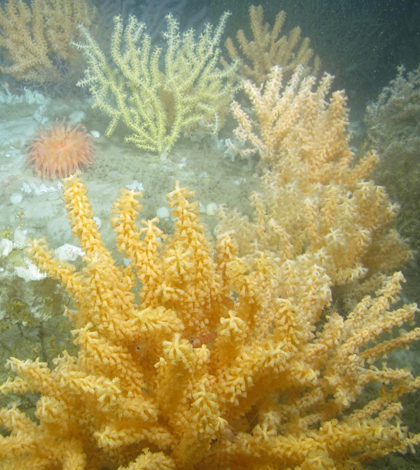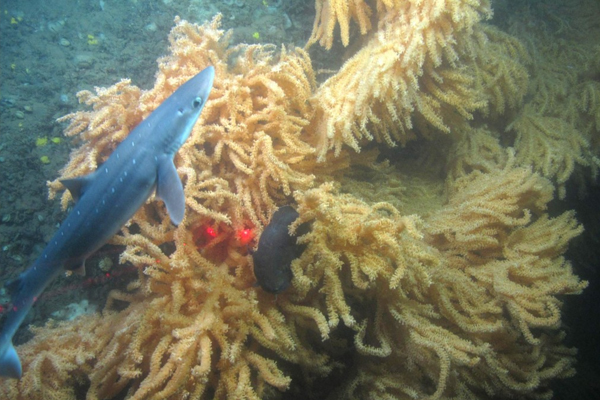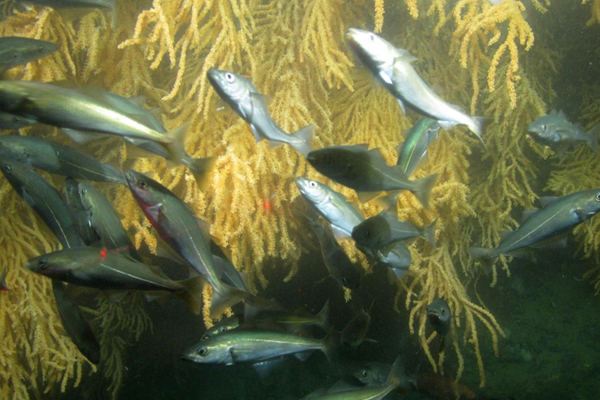After Years Of Search, Corals Found Living In Gulf Of Maine

Coral garden habitat in Western Jordan Basin. Sea fans, sponges and anemones cover the rocky ridge. (Credit: Peter Auster)
Going back hundreds of years, fishermen in the Gulf of Maine had told tales of pulling up bits of coral after trawling. These led to some educated guesses as to where the coral populations could be, but they were just guesses after all.
To eliminate some of the uncertainty, researchers at the University of Connecticut’s Northeast Underwater Research, Technology and Education Center (NURTEC) set out to investigate. They began searching for the coral communities in 2013, navigating the Gulf of Maine from Cape Cod, Massachusetts to the western tip of Nova Scotia. They rode on the R/V Connecticut and used remotely controlled underwater vehicles equipped with cameras to scour the Gulf for signs of coral.
Scientists rightly wanted to see if the corals even existed in the first place. But if there were corals found, protecting and conserving them would become necessary.
“Deep sea coral communities are sensitive to environmental changes and vulnerable to human activities such as commercial fishing and oil and gas exploration. Federal legislation acknowledges these problems and the need for conservation,” said Peter Auster, a research professor emeritus of marine sciences at U. Connecticut, in a statement. “In fact, the United Nations General Assembly has passed several resolutions that are focused on this deep sea coral and other ecologically sensitive communities because of their vulnerability to outside forces. That’s why we set out to find what might still be hidden in the Gulf of Maine.”

As a spiny dogfish, a species in the shark family, searches for prey, a cusk (center) dives into the coral to hide. (Credit: Peter Auster)
In 2013, they pinpointed the locations of three areas containing dense patches of coral. Their work has continued through this year and benefited from more ship time and advanced research tools.
In a post on the NURTEC website, a description of the tech used explains some of the improvements that aided surveying efforts. Twenty-six tows were completed through the July 2015 sampling period using the ISIS2 Towed Camera System.
“The ISIS2 camera sled was equipped with both down- and forward-looking hi-def video cameras and a down-looking digital still camera,” the post reads. “For 2015, NURTEC integrated two thrusters onto the sled to provide much-improved and much-needed maneuverability that allowed the system to be better positioned in the rugged topography and deal with the strong currents of the Gulf of Maine.”
The enhancements helped the researchers discover two more coral sites in the Gulf of Maine, bringing the total to five. These hold some amazing specimens, including different sponges, primnoa coral gardens and rare pom-pom anemones.
For Auster, who had started looking for deep sea corals in the Gulf of Maine all the way back in 2002, the discoveries came as a surprise.

Pollock and Atlantic cod swim along a coral-covered wall at Outer Schoodic Ridge, feeding on abundant krill. (Credit: Peter Auster)
“We did find a few limited sites (back then), but nothing like what we’ve found in the past few years,” said Auster in the release. “It’s amazing we have been able to make these types of discoveries in one of the most well-studied parts of the global ocean, and after a bit more than half a century of people diving with submersibles in this region. I’ve been doing this kind of work for over 30 years, and I was stunned when we first found these rock walls literally blanketed in coral.”
Identifying the existence of these coral communities will help marine scientists learn more about the ecological roles they play in mediating patterns of biodiversity in deep continental shelf habitats. And knowledge of their locations will also help conservation and management plans being developed for the Gulf by the New England Fishery Management Council and the National Oceanic and Atmospheric Administration (NOAA).
Funding for the work was provided by the Federal Deep Sea Coral Research and Technology Program, which is sponsored by NOAA.
Top image: Coral garden habitat in Western Jordan Basin. Sea fans, sponges and anemones cover the rocky ridge. (Credit: Peter Auster)





0 comments